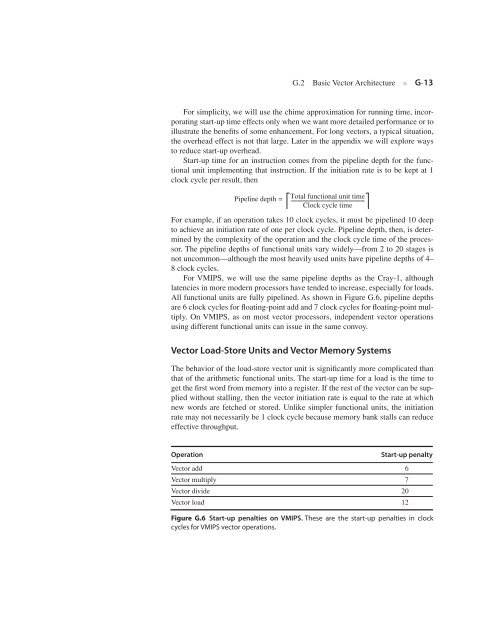Appendix G - Clemson University
Appendix G - Clemson University
Appendix G - Clemson University
Create successful ePaper yourself
Turn your PDF publications into a flip-book with our unique Google optimized e-Paper software.
G.2 Basic Vector Architecture ■ G-13<br />
For simplicity, we will use the chime approximation for running time, incorporating<br />
start-up time effects only when we want more detailed performance or to<br />
illustrate the benefits of some enhancement. For long vectors, a typical situation,<br />
the overhead effect is not that large. Later in the appendix we will explore ways<br />
to reduce start-up overhead.<br />
Start-up time for an instruction comes from the pipeline depth for the functional<br />
unit implementing that instruction. If the initiation rate is to be kept at 1<br />
clock cycle per result, then<br />
Pipeline depth =<br />
Total functional unit time<br />
------------------------------------------------------------<br />
Clock cycle time<br />
For example, if an operation takes 10 clock cycles, it must be pipelined 10 deep<br />
to achieve an initiation rate of one per clock cycle. Pipeline depth, then, is determined<br />
by the complexity of the operation and the clock cycle time of the processor.<br />
The pipeline depths of functional units vary widely—from 2 to 20 stages is<br />
not uncommon—although the most heavily used units have pipeline depths of 4–<br />
8 clock cycles.<br />
For VMIPS, we will use the same pipeline depths as the Cray-1, although<br />
latencies in more modern processors have tended to increase, especially for loads.<br />
All functional units are fully pipelined. As shown in Figure G.6, pipeline depths<br />
are 6 clock cycles for floating-point add and 7 clock cycles for floating-point multiply.<br />
On VMIPS, as on most vector processors, independent vector operations<br />
using different functional units can issue in the same convoy.<br />
Vector Load-Store Units and Vector Memory Systems<br />
The behavior of the load-store vector unit is significantly more complicated than<br />
that of the arithmetic functional units. The start-up time for a load is the time to<br />
get the first word from memory into a register. If the rest of the vector can be supplied<br />
without stalling, then the vector initiation rate is equal to the rate at which<br />
new words are fetched or stored. Unlike simpler functional units, the initiation<br />
rate may not necessarily be 1 clock cycle because memory bank stalls can reduce<br />
effective throughput.<br />
Operation Start-up penalty<br />
Vector add 6<br />
Vector multiply 7<br />
Vector divide 20<br />
Vector load 12<br />
Figure G.6 Start-up penalties on VMIPS. These are the start-up penalties in clock<br />
cycles for VMIPS vector operations.

















